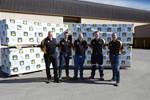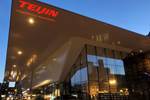IsoTruss engineers carbon fiber tower for Wyoming Bureau of Land Management
Lightweight, durable IsoTruss carbon fiber tower addresses high winds, snow and ice impacting remote Elk Mountain communications infrastructure.
Photo Credit, all images: IsoTruss
(Springville, Utah, U.S.) has installed a lightweight, durable IsoTruss carbon fiber cell tower solution for the ’s (BLM) remote critical communications infrastructure located at the top of Elk Mountain, Wyo., U.S.
“Our team utilizes IsoTruss geometry, made with composites, to provide creative engineering applications to difficult problems,” Nathan D. Rich, founder and CEO, IsoTruss Inc., says. “The is a great example of our helping a client resolve an ongoing repair and maintenance issue at a remote critical infrastructure site with a sustainable, innovative solution.”
The Elk Mountain system shelter, which features an articulating tower mast, is a major communications site servicing approximately 180 square miles. The Wyoming BLM manages emergency communications for wildland fires, along with any aircraft — including federal aircraft — helping with wildland fires, as well as managing communications with administrative and other staff, such as biologists conducting field activity for the BLM.
With high winds of up to 120 miles per hour, along with 9-10 feet of snow and ice during winter, the steel tower mast has repeatedly snapped at the bolts, or hinging section, over the past four years, causing the tower antenna to end up on the ground multiple times. To solve the issue, IsoTruss engineered and transported a 40-foot IsoTruss carbon fiber tower weighing 250 pounds, then bolted and connected it to the existing system shelter. The tower was delivered to the remote site with a light-duty truck and installed using manpower in a single day.
“The original tower kept breaking at the hinge, and we needed a solution, but in this situation, it had to be customized,” Vance Andersen, BLM Wyoming telecom manager, explains. “IsoTruss was able to design a tower solution that fit like a glove, which was impressive. Plus, at BLM, we deal with lifecycle use, so in addition to the lightweight attribute of the structure, what really caught my eye was the lack of carbon footprint that it leaves by producing it. At BLM, we're trying to take care of the lands, so we want to make sure that we try for the least impact as possible for the environment.”
IsoTruss solutions are well-suited to high wind, snow and ice environments in mountain settings and hurricane/typhoon-prone regions. This is mostly due to the corrosion resistance of the composite material and the high wind resistance of the IsoTruss lattice geometry. Each cell tower is designed and manufactured to meet the firm’s own rigorous design and production standards, various local, state and federal regulations and Telecommunications Industry Association (TIA) and AASHTO standards.
Related Content
-
Carbon fiber composite pallet revolutionizes freight industry
LOG Point Pallet fuses advanced materials with innovative design and manufacturing to improve supply chains worldwide.
-
Low-cost, efficient CFRP anisogrid lattice structures
CIRA uses patented parallel winding, dry fiber, silicone tooling and resin infusion to cut labor for lightweight, heavily loaded space applications.
-
Welding is not bonding
Discussion of the issues in our understanding of thermoplastic composite welded structures and certification of the latest materials and welding technologies for future airframes.






